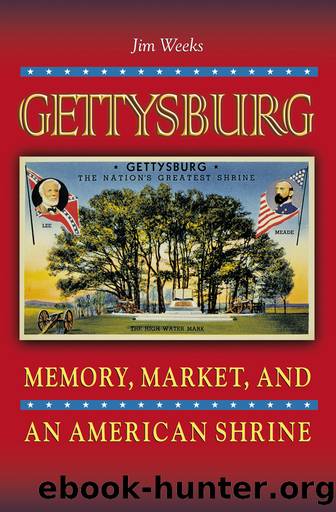Gettysburg by Jim Weeks

Author:Jim Weeks [Weeks, Jim]
Language: eng
Format: epub
ISBN: 9781400832545
Publisher: PrincetonUP
Published: 2021-07-15T00:00:00+00:00
The Image of a Cold War Shrine
Gettysburgâs salience during the Cold War era owed something to a media event beyond manipulation of memory. During the 1950s, Gettysburg shone in the media spotlight as the home of the nationâs chief executive. Dwight D. Eisenhower, hero of World War II and president from 1953 to 1961, bought a Gettysburg farm in 1954 with hopes of retiring there. The first home âIkeâ and his wife Mamie ever owned, the 496-acre farm, consummated the coupleâs pleasant memories of Gettysburg framed decades earlier when Ike served as commander of a tank school at Gettysburg. Ikeâs retirement plans accelerated, however, when he opted to recuperate in Gettysburg from a 1955 heart attack. As a result, Gettysburg continuously appeared in the news.58
After Ike set up a presidential office in the Gettysburg post office, U.S. News and World Report called Gettysburg âthe unofficial capital of the nation.â Cabinet members came to visit, news conferences were held in the Hotel Gettysburg, and crowds gathered when Ike arrived in town. Cameras snapped and whirred when Ike brought famous people to Gettysburg such as Bernard Montgomery, Winston Churchill, Nikita Khruschev, or Charles de Gaulle. It may have been an exaggeration that the battlefield ânow ranks second to Mr. Eisenhower as a tourist attraction,â as U.S. News concluded, but the Eisenhowers encouraged construction of several motels, restaurants, and the sale of âIke and Mamieâ souvenirs. Ike, however, represented more than a television celebrity like Cliff Arquette. After all, the Cincinnatus of Western civilization opted to settle at the pastoral site of the Civil Warâs greatest battle. As chief executive of a nation characterized by both unparalleled affluence and tension, his avuncular visage provided comfort from Cold War hostility and domestic change. Reported to be small-town âeveryday folksâ by the people of Gettysburg, the Eisenhowers on their little farm offered a model for lackadaisical withdrawal from the worldâs problems. Ike easily folded into Gettysburgâs image not only as a quintessential American tourist site but a place of retreat. In effect, the couple functioned as the Good Housekeeping seal of approval for Gettysburg.59
Neither Ike nor Gettysburg were fossilized relics fissured from the present, as each strengthened the other to forge contemporary meaning for the shrine. Ike, now commander in chief, had been helmsman of victory in Europe and could handily manage national challenges; Gettysburg, site of national tragedy and renewal, also provided confidence for confronting the future. The match dovetailed easily into the eraâs anachronistic dissonance: colonial furniture and space age design, religious faith and faith in technology, Disneyâs Tomorrow Land and Frontier Land, Davy Crockett and Elvis, Grandma Moses and Jackson Pollack, Westerns and outer space.60
Ike invigorated the shrine about the same time mass culture began to split the past from the present. Tourism had changed, and so had Gettysburgâs sacred significance for a nation confronted with freedom at home and abroad. The Cold War revived Gettysburgâs symbolic place in American exceptionalism, expressed as the rebirth of a nation divinely ordained for global leadership.
Download
This site does not store any files on its server. We only index and link to content provided by other sites. Please contact the content providers to delete copyright contents if any and email us, we'll remove relevant links or contents immediately.
| Africa | Americas |
| Arctic & Antarctica | Asia |
| Australia & Oceania | Europe |
| Middle East | Russia |
| United States | World |
| Ancient Civilizations | Military |
| Historical Study & Educational Resources |
The Dawn of Everything by David Graeber & David Wengrow(1647)
The Bomber Mafia by Malcolm Gladwell(1583)
Facing the Mountain by Daniel James Brown(1503)
Submerged Prehistory by Benjamin Jonathan; & Clive Bonsall & Catriona Pickard & Anders Fischer(1419)
Wandering in Strange Lands by Morgan Jerkins(1372)
Tip Top by Bill James(1350)
Driving While Brown: Sheriff Joe Arpaio Versus the Latino Resistance by Terry Greene Sterling & Jude Joffe-Block(1338)
Evil Geniuses: The Unmaking of America: A Recent History by Kurt Andersen(1316)
Red Roulette : An Insider's Story of Wealth, Power, Corruption, and Vengeance in Today's China (9781982156176) by Shum Desmond(1314)
The Way of Fire and Ice: The Living Tradition of Norse Paganism by Ryan Smith(1304)
American Kompromat by Craig Unger(1268)
It Was All a Lie by Stuart Stevens;(1263)
F*cking History by The Captain(1254)
American Dreams by Unknown(1234)
Evil Geniuses by Kurt Andersen(1223)
Treasure Islands: Tax Havens and the Men who Stole the World by Nicholas Shaxson(1219)
White House Inc. by Dan Alexander(1177)
The First Conspiracy by Brad Meltzer & Josh Mensch(1139)
The Fifteen Biggest Lies about the Economy: And Everything Else the Right Doesn't Want You to Know about Taxes, Jobs, and Corporate America by Joshua Holland(1089)
